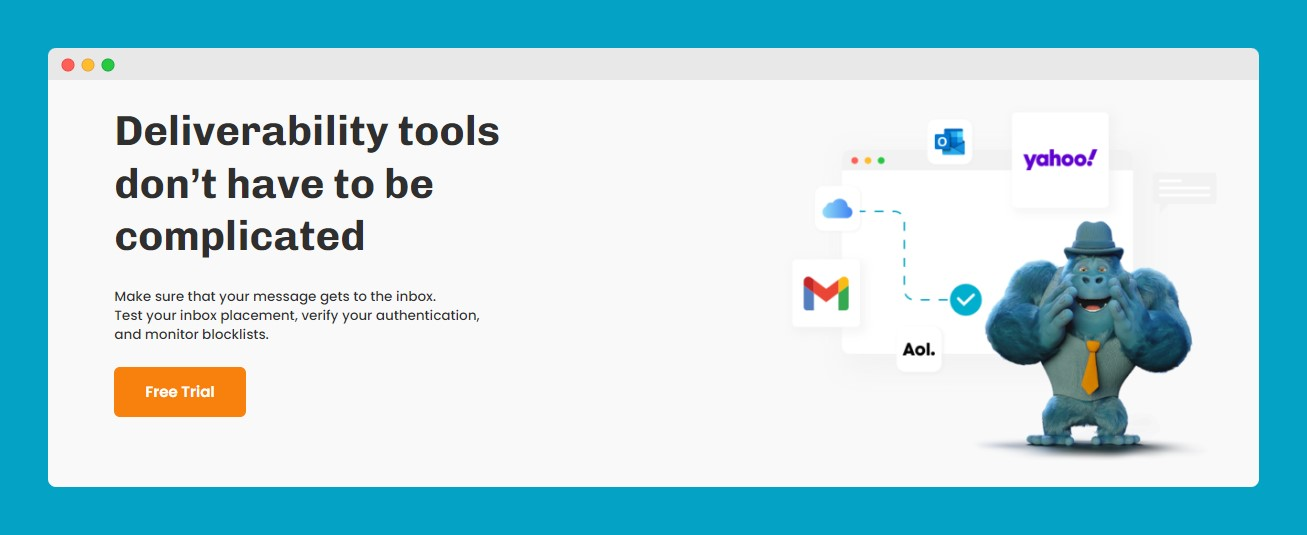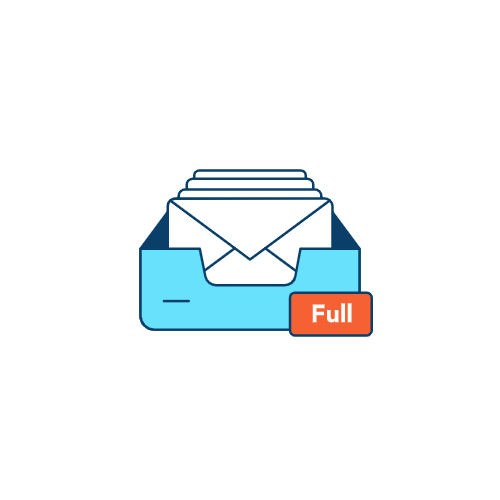Are you not coping with delivering your email addresses, or just want to improve your performance? Then we have something for you.
In this article, we’ll share actionable tips to improve email deliverability and answer many burning questions, like “What is email deliverability?” and “What is a good deliverability rate?” You will also discover an effective tool to test email deliverability and improve your chances of reaching your customers’ inboxes.
What is email deliverability, and why does it matter?
Email deliverability refers to the ability of an email to successfully land in a recipient’s inbox rather than being filtered into the dreaded spam folder.
Email deliverability plays a crucial role in email marketing as it directly impacts the reach and effectiveness of your campaigns. Email providers monitor your engagement rates, spam complaints and other information coming from your email address, and all of this affects your deliverability.
For instance, imagine running an e-commerce business and sending out promotional emails to your customers. If your emails consistently end up in the spam folder or encounter deliverability issues, your recipients won’t even see them, resulting in missed opportunities and poor email marketing performance.
Email service providers, mail servers, and even a single internet service provider evaluate different factors to determine if an email should be successfully delivered. Based on how good the email content is that comes from your email domain, they assign a value called domain reputation. The better your deliverability, the better the domain reputation.
Therefore, understanding and optimizing deliverability rates can ensure that your valuable messages make it to the intended recipients, enhancing the success of your email marketing efforts.
The larger the volume of emails you send, the more important is is to reach the primary inboxes and have rock solid domain reputation.
What is a good deliverability rate?
According to Shopify, if your email deliverability rate is 97%, you should do some audits to improve your score. But let’s be honest – if you don’t hit 100% deliverability, you always have room for improvement, whether it’s transactional emails, cold emails or something else.
Apart from that, it’s fair to say that good email delivery rates start from 95% and up. Even those senders can have email deliverability issues, but they have a proven track record of sending legitimate emails, which means they have all their bases covered.
Let’s look at an example: you send emails to a list of 2,500 subscribers. With a 95% delivery rate, around 2,374 of your emails would land in the recipients’ inboxes, ensuring that your message reaches a vast majority of your subscribers.
The remaining 125 messages did not reach their recipients. And that’s as many as 125 missed opportunities for a reply or a conversion.
In 2022, almost 49% of emails worldwide landed in the spam folder. If you don’t want to be in this bracket, it’s time to change something and fix those email deliverability issues.
But why should you even care? It’s simple – because you want to communicate effectively with your audience and not waste your resources. In addition, email marketing revenue is about to grow and grow, so this is a big chance to boost your business.
Bounce rate explained
When it comes to email deliverability, the bounce rate plays a significant role here. But what exactly is it?
In email marketing, a bounced email occurs when your carefully crafted marketing emails fail to reach their intended recipients and come back to you.
Such bounces can be classified into two types: soft bounces and hard bounces.

▶️ Soft bounce
Soft bounces let you know that your email is temporarily unable to reach the recipient. It could be due to reasons like:
- a full inbox,
- a temporary issue with the recipient’s mail server,
- or the email being flagged as spam.
However, soft bounces don’t necessarily mean the end of the road for your email. With a bit of luck, your email might find its way into the inbox on a subsequent attempt.
▶️ Hard bounce
A hard bounce, on the other hand, refers to an undeliverable email that permanently fails to reach its intended recipient. It is a clear signal that the email cannot be delivered.
This could be due to reasons like:
- an invalid or non-existent email address,
- a blocked sender,
- poor sender reputation.
A poor sender reputation may result in low sender scores and dives into wasted efforts and spam emails. This, unfortunately, will prevent you from running a successful email marketing campaign.
So, in case of a hard bounce, the email is undeliverable and won’t make it to the recipient’s inbox. Therefore, reducing your bounces is crucial for ensuring that your marketing emails land in your subscribers’ inboxes.
With our tips, you can reduce your unsubscribes, and by following a few basic rules, such as using double opt-in and adhering to the sender policy framework, you can increase the chances of your emails successfully reaching your audience.
Regardless of your email frequency and the type of emails you send, having high bounce rates affects your email sender reputation and is a serious issue that should be looked into.
How to test email deliverability
Remember, a low bounce rate leads to many benefits, like:
👉 higher engagement metrics (conversion rate, click-through rate, open rate, improved unsubscribe rates),
👉 better email performance,
👉 and the opportunity to build a base of loyal customers with impeccable list hygiene.
What you will need is to test your email deliverability.
And here, Bouncer can prove indispensable. 💪🏻
Manually testing the behavior of your emails is time-consuming and not very accurate. But you don’t have to resort to this solution at all, as you can use the Bouncer Deliverability Kit.

The Bouncer Deliverability Kit is a powerful tool that can significantly enhance your email deliverability. This package provides you with valuable insights and resources to improve the chances of your emails reaching the intended recipients’ inboxes.
Let’s take a quick look at how the Bouncer Deliverability Kit can help.
📤 Inbox placement
Thanks to this testing feature, you can check how your emails will be delivered, how many end up in a spam folder, and how many will be displayed across various email service providers (ESPs). This allows you to identify any potential deliverability issues and make necessary adjustments to improve your inbox placement rates.
⚙️ Email set-up
Along with the deliverability testing features, the Bouncer Deliverability Kit allows you to verify your email server setup and email authentication, including SPF, DKIM, and DMARC. This ensures that your emails are properly authenticated and increases their chances of successful delivery.
📧 Deliverability monitoring
The Bouncer Deliverability Kit also provides ongoing monitoring of your email deliverability performance. It keeps track of metrics like spam complaints and sender reputation. Keeping an eye on these key indicators, you can proactively address any deliverability issues and maintain a healthy sender’s reputation.
📩 Email campaign protection
The kit enables you to run your emails through comprehensive testing algorithms. It analyzes various factors that may cause your message hit the spam folder, such as subject lines, content, and formatting. Thanks to identifying and addressing potential spam triggers, you can enhance your email’s chances of bypassing spam folders and reaching the recipients’ primary inboxes.
How to improve email deliverability
Several factors influence email deliverability and open rates, for example:
- sender reputation,
- the subject line,
- spam traps in your recipient list,
- inactive subscribers,
- the recipient’s server.
But that is not everything.
If you want to improve your email deliverability, you can take advantage of email marketing best practices.
#1 Clean up and verify your lists
Maintaining a clean and verified email list is crucial for improving deliverability. That’s why you need to remove invalid emails regularly or, if necessary, inactive contacts to ensure that you’re targeting engaged users who are more likely to open and interact with your emails.
When eliminating outdated or non-existent addresses, you can avoid hard bounces and improve email marketing campaigns.

Consider using email marketing software and email verification tools like Bouncer to automatically check the validity of email addresses and remove any potential threats to deliverability. This way, you can focus your efforts on reaching a genuinely interested audience and maximize the impact of your email campaign.
#2 Only send emails to people who opted in to receive them
Sending emails to recipients who have explicitly opted in shouldn’t be only a good practice but a golden rule. If you obtain permission from your email subscribers, you ensure that your emails are more likely to be welcomed rather than placed in the spam folder.
Email service providers and internet service providers take note of engagement metrics, such as open rates and spam reports, to determine the quality of your email campaigns. And if you keep a list of engaged subscribers, you can improve your sender score and avoid the dreaded spam folder.
Therefore, focus on building an engaged audience through an ethical and transparent opt-in process to maximize your email deliverability.
#3 Do not purchase email lists
While it may be tempting to acquire a large email list for your marketing efforts, purchasing them is a big no-no. ❌
Such an email list often consists of outdated or low-quality contacts, leading to high bounces and potential spam complaints. Sending emails to individuals who haven’t explicitly opted in can harm email marketers’ IP reputation and negatively impact delivery to a user’s inbox.
Instead, invest your time and resources in building your own email list organically. By attracting subscribers who are genuinely interested in your content or offerings, you can maintain a higher level of engagement and deliverability.
#4 Make it easy to unsubscribe
Another best practice is offering a simple and visible unsubscribe option in your emails. When recipients find it difficult to unsubscribe, they may resort to marking your emails as spam, which can damage your sender’s reputation.

In contrast, email marketing platforms should provide an easy and prominent way for subscribers to opt-out options to demonstrate respect for clients’ preferences and reduce the likelihood of spam reports.
And great email delivery services not only contribute to better deliverability but also foster trust and loyalty among your subscribers.
#5 Authenticate your emails
Email authentication is another crucial step in improving deliverability. Implementing authentication protocols like:
- SPF (Sender Policy Framework),
- DKIM (Domain Keys Identified Mail),
- and DMARC (Domain-based Message Authentication, Reporting, and Conformance)
All of this helps verify your identity as a sender and prevents spoofing or unauthorized use of your dedicated IP address.
These authentication mechanisms enable service providers to recognize your emails as legitimate and trustworthy, increasing the chances of landing in recipients’ inboxes rather than being negatively marked by spam filters.
Thus, authenticate your emails by properly configuring these protocols and get your emails delivered thanks to tools like Bouncer, which supports and facilitates email authentication.
#6 Do not use spammy language in your emails
One last obvious thing worth remembering – avoid spammy language and tactics in your email campaign.
Certain trigger words or phrases can raise red flags for spam filters and result in your emails being flagged or filtered. 🚩
Steer clear of:
- excessive use of capital letters, e.g., GET YOUR FREE GIFT NOW
- multiple exclamation marks, e.g., Hurry!!! Limited-time offer!!!!
- misleading subject lines, e.g., You’ve won a prize! (Just kidding…)
- and overly salesy or aggressive language, e.g., buy now or regret it forever! Don’t miss out on this amazing deal!
Instead, focus on providing value, relevant content, and personalized messaging that resonates with your audience. Adopting a professional and respectful tone will let you improve the chances of your emails reaching the intended recipients’ inboxes, boosting subscriber engagement, and fostering a positive relationship.
The above tips are incredibly important for success. And on top of that, stay in touch with your clients, collect and act upon feedback, and regularly monitor deliverability metrics, as they are essential for email delivery.
Improve your email deliverability and sender reputation
Delivering emails is not that difficult, but you need to know how to do it effectively. With our tips, you’re sure to be more productive. And with more practice, you’re well on your way to mastering the art of successful email delivery.
The inbox is your friend, and with a little effort and the help of outstanding tools, you’ll conquer it like a pro.
Bouncer will equip you with the necessary tools and insights to optimize your email deliverability. As a result, you will be able to improve your inbox delivery rates, minimize the risk of your emails being marked as spam, and ensure that your messages reach the right audience effectively.
So go forth, and start delivering with Bouncer!
FAQs
#1 What is email deliverability?
Generally speaking, email deliverability refers to whether an email arrives in a recipient’s inbox rather than being filtered as spam. It plays a crucial role in email marketing as it directly impacts the reach and effectiveness of your campaigns.
#2 What is a good deliverability rate?
A good deliverability rate falls within the range of 95% and above. Achieving a 95% delivery rate means that out of 2,500 emails sent, approximately 2,374 would reach the recipients’ inboxes. Focusing on deliverability is crucial for effective communication.
#3 What is the bounce rate?
Bounce rate is the percentage of emails that fail to reach their intended recipients. It can be classified into two types: soft bounces, which are temporary delivery failures, and hard bounces, which indicate undeliverable emails.
#4 How to test email deliverability?
To test your email deliverability, you can use the Bouncer Deliverability Kit, a powerful tool that provides valuable insights and resources. It allows you to check inbox positions, verify email server setup and authentication (SPF, DKIM, DMARC), and monitor deliverability performance.
#5 How to improve email deliverability?
To improve your email deliverability, you can clean up your email lists, send emails to people who have opted in to receive them, avoid purchasing email lists, allow subscribers to unsubscribe easily, authenticate your emails using protocols like SPF, DKIM, and DMARC, and avoid using spammy language.




